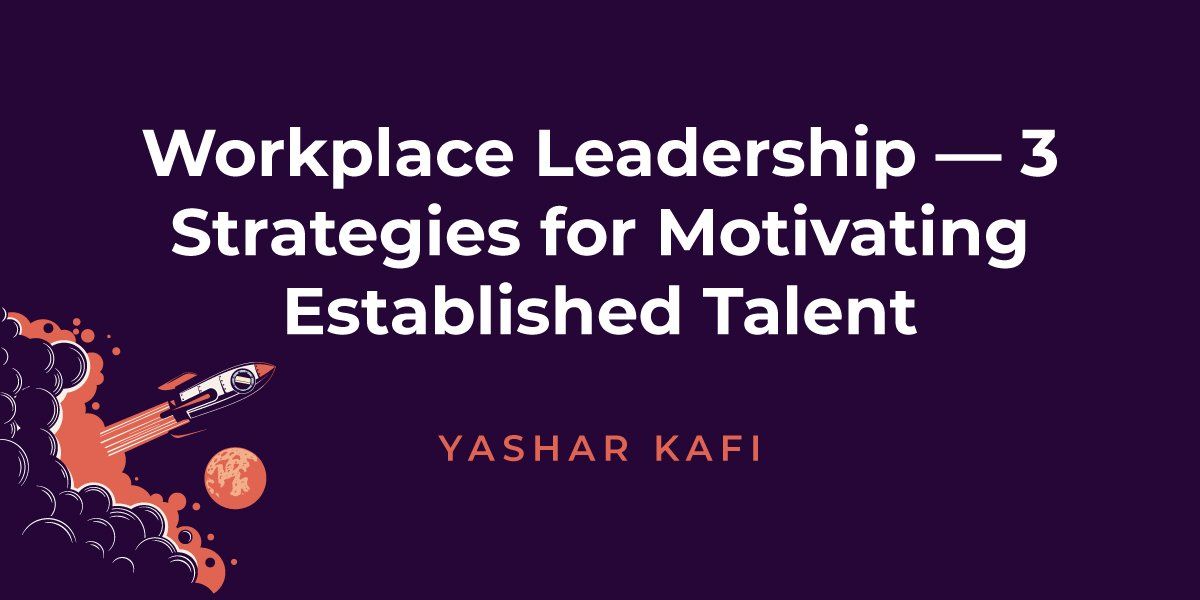Workplace Leadership — 3 Strategies for Motivating Established Talent
Successful workplace leadership requires a leader to wear many hats to different people across various career stages. For leaders looking for insights on leading team members at the earliest stages of their careers, there tends to be more information and advice to glean from.
But what about those team members who are middle-stage talent—not fresh out of university yet still in need of guidance, support, and encouragement to reach their
career goals? I’m sharing three simple strategies for successfully motivating your established talent as they continue their way up. You want to do your best to help them do their best, and here’s how.
Workplace Leadership and Established Talent
The middle stage is often the most challenging, where talent is already into their career and making some real headway. They’ve already got some skills, learned a lot, and made a few mistakes.
It’s really about adapting and incorporating all that they’re learning into your corporate methodology—your operating model—which is not easy to do. It’s your job to fulfill your role in workplace leadership to help them get there as smoothly and with as much encouragement, empowerment, and support as possible.
Obviously, established talent is different than a new workforce, and you have to approach them accordingly, but there are even dividers within this middle talent tier. I’m talking about the great divide between two major generations: Gen X and millennials.
The saying “age is just a number” sounds nice and all. But in some areas—like stages in a career and how a generation influences what you’re looking for and need—it helps a leader understand where you are coming from, so they can find the best approach to motivate you.
So, let’s look at both generations to highlight key differences to help you adapt your workplace leadership approach to motivating each.
Workplace Leadership and Strategies for Motivating Millennials
According to workplace statistics, millennials make up 35% of the workforce in the U.S., and it’s estimated that they’ll represent 75% of the global workforce by 2025. So, it’s essential that corporate leaders motivate them and help them grow their careers. And how do we do that? It’s easy: Find out what motivates them.
Millennials’ job satisfaction is mainly based on two main criteria: salary and job security. They are also a socially driven generation, placing a high premium on businesses that focus on improving and benefiting society.
A good strategy for motivating millennials is to show social responsibility while providing them with clear steps forward in their development. And this is a big one: also offer fair pay. Basically, they want to see you care (about them and society at large), but they also want you to show them the money.
Workplace Leadership and Strategies for Motivating Gen X
As a generation that grew up coming home from school to an empty house because most parents were away from home during the day working, they earned the nickname “latchkey kids.” It should be no surprise that Generation X is considered independent, self-reliant, self-sufficient, resourceful, and adaptable. This goes for life, as well as in the workplace.
To motivate them, respect this “I can do it myself” attitude with an open management style that is a bit less structured or what they would consider confining. Micromanaging is a no-go with this generation, as this often hinders their greatest strengths: their creativity and skill at taking the initiative and working independently.
Motivating Those Who Do Not Want to Lead
Then, there’s a third place some middle-talent comes from: the land of non-leaders. Let’s face it: Some people don’t want to become leaders as they move up the corporate ladder. Sometimes that can be disappointing—even frustrating—for leaders.
So, what can you do? We have to accept that and focus instead on learning what they are passionate about, then encourage them in a way that furthers the organization’s goals, too.
The bottom line is that good workplace leaders can manage all kinds of people, whether they’re individuals who are natural-born leaders or not.
Ready to up your workplace leadership game? Connect with us to learn more.




